Sony VGN-A230, VGN-A230B, VGN-A230P, VGN-A240, VGN-A240B User Guide
...
Welcome
Congratulations on your purchase of this Sony VAIO® computer, and welcome to the online VAIO® Computer User Guide. This user guide provides detailed information on all aspects of using your new VAIO computer, from keyboard functions to preinstalled software programs.
In the left navigation window, click the topics you want to learn more about, and that information will be displayed in this main window.
 View the Electronic Flyer, which provides updates and supplemental information about your computer.
View the Electronic Flyer, which provides updates and supplemental information about your computer.
 Go to the Sony Computing Support Web site to view the VAIO® Computer Specifications, which list your computer's hardware specifications and preinstalled software information.
Go to the Sony Computing Support Web site to view the VAIO® Computer Specifications, which list your computer's hardware specifications and preinstalled software information.
For Sony software information, click Start and select Welcome to VAIO life.
Page 1

Ergonomics and Caring for Your Computer
This section provides information on how to safely use your Sony computer.
Page 2

Applying Ergonomics
Your computer is a portable device and can be used in a variety of environments. Whenever possible, you should apply the following ergonomic considerations:
Position of your computer — Place the computer directly in front of you as you work. Keep your forearms horizontal, with your wrists in a neutral, comfortable position while using the keyboard, touch pad, or external mouse. Let your upper arms hang naturally at your sides. Take breaks during sessions with your computer. Excessive use of the computer may strain muscles or tendons.
Furniture and posture — Sit in a chair with good back support and armrests. Adjust the level of the chair so your feet are flat on the floor. A footrest may make you more comfortable. Sit in a relaxed, upright posture and avoid slouching forward or leaning far backward.
Viewing angle of the computer's display — Tilt the display to find the best viewing angle. Also try adjusting the brightness setting of the display. Following these suggestions can reduce eye strain and muscle fatigue.
Lighting — Choose a location where windows and lights do not create glare or reflection on the display. Use indirect lighting to avoid bright spots on the display. You can purchase accessories for your display that help reduce glare. Proper lighting adds to your comfort and work effectiveness.
Placement of an external display — When using an external display, set the display at a comfortable viewing distance. Make sure the display screen is at eye level or slightly lower when you are sitting in front of the monitor.
Page 3

Storing Your Computer
Do not use or store your computer in a location subject to:
Heat sources, such as radiators or air ducts
Direct sunlight
Excessive dust
Moisture or rain
Mechanical vibration or shock
Strong magnets or speakers that are not magnetically shielded
Ambient temperature higher than 95ºF (35ºC) or less than 40ºF (5ºC)
High humidity
Do not place electronic equipment near your computer. When running, the computer's electromagnetic field may cause other electronic equipment in close proximity to malfunction.
Provide adequate air circulation to prevent internal heat buildup. Do not place your computer on porous surfaces such as rugs or blankets, or near materials such as curtains or draperies that may block ventilation. Leave a space of at least 8 inches (20 cm) behind the back of the computer.
If the computer is brought directly from a cold location to a warm one, moisture may condense inside your computer. In this case, allow at least one hour before turning on your computer. If any problems occur, unplug your computer, and contact your Sony Service Center.
The computer uses high-frequency radio signals and may interfere with radio or TV reception. Should this occur, move the computer a suitable distance away from the radio or TV.
Do not drop the computer or place heavy objects on top of the computer.
Page 4

Using Cables and Connections
Use only specified peripheral equipment and interface cables.
Do not use cut or damaged connection cables.
If the telephone company makes a service call to your home or office and determines that your computer is responsible for a problem, the telephone company may bill you for the service call. Also, if you do not disconnect your computer when it is adversely affecting a telephone line, the telephone company has the right to disconnect your service until you correct the problem.
Page 5

Cleaning and Maintaining Your Computer
Clean the computer with a soft, dry cloth or a soft cloth lightly moistened with a mild detergent solution. Do not use any type of abrasive pad, scouring powder, or solvent such as alcohol or benzine, as these may damage the finish of your computer. You can use canned compressed air specifically for computers to remove dust.
If a solid object falls onto the computer or a liquid leaks into the computer, immediately turn off and unplug the computer. It is best to have the computer checked by qualified personnel before you use it again.
Avoid rubbing the LCD screen as this can damage the screen. Use a soft, dry cloth to wipe the LCD screen or canned compressed air.
Always disconnect the power cord before cleaning the computer.
Your computer is equipped with a cooling fan and heat sink that help your computer maintain a safe operating temperature. These areas must be kept clean and free from debris, such as dust, dirt, pet hair, or other particles that can restrict the flow of air. If dust is allowed to accumulate in the cooling fan and heat sink area, your computer may overheat and stop operating properly.
Avoid using your computer in locations that are subject to excessive dust or dirt, such as the floor or on the ground.
Avoid using your computer on or near surfaces that may have dust or shedding fibers, such as rugs, blankets, curtains, or draperies.
Avoid using your computer in areas where pets are kept, or pet hair accumulates.
Page 6

Handling the LCD Screen
Direct sunlight can damage the LCD. Be careful when using the computer near a window.
Do not scratch the LCD or exert pressure on it. This can cause a malfunction.
Using the computer in low temperature conditions may produce a residual image on the screen. This is not a malfunction. When the computer returns to normal temperature, the screen returns to normal.
The screen becomes warm during operation. This is normal and does not indicate a malfunction.
The LCD is manufactured using high-precision technology. You may, however, see tiny black points and/or bright points (red, blue, or green) that continuously appear on the LCD. This is a normal result of the manufacturing process and does not indicate a malfunction.
Page 7

Locating Controls and Ports
Congratulations on your purchase of the Sony® VAIO® computer. Sony has combined leading-edge technology in audio, video, computing, and communications to provide state-of-the-art personal computing.
Front
1 |
LCD screen |
10 |
Memory Stick® media indicator |
|
2 |
Mute button |
11 |
Wireless switch1 |
|
3 |
Volume buttons |
12 |
Bluetooth® indicator2 |
|
4 |
Brightness button |
13 |
Wireless indicator3 |
|
5 |
Magnify screen button |
14 |
Power indicator |
|
6 |
S1 button |
15 |
Battery indicator |
|
7 |
Keyboard |
16 |
Hard disk drive indicator |
|
8 |
Touch pad |
17 |
Optical drive indicator |
|
9 |
Memory Stick® media slot4 |
|
|
|
1 |
Wireless LA N and Bluetooth functionality available on selected models only. |
|||
2 |
Wireless LA N and Bluetooth functionality available on selected models only. |
|||
3 |
Wireless LA N and Bluetooth functionality available on selected models only. |
|||
4 |
Your computer supports Memory Stick Duo media and Memory Stick PRO high speed and high capacity capabilities. |
|||
 Do not insert more than one Memory Stick media into the Memory Stick media slot as it may damage the computer.
Do not insert more than one Memory Stick media into the Memory Stick media slot as it may damage the computer.
Insert the Memory Stick media with the arrow facing up and toward the slot. Inserting the media improperly may damage the computer. Page 8
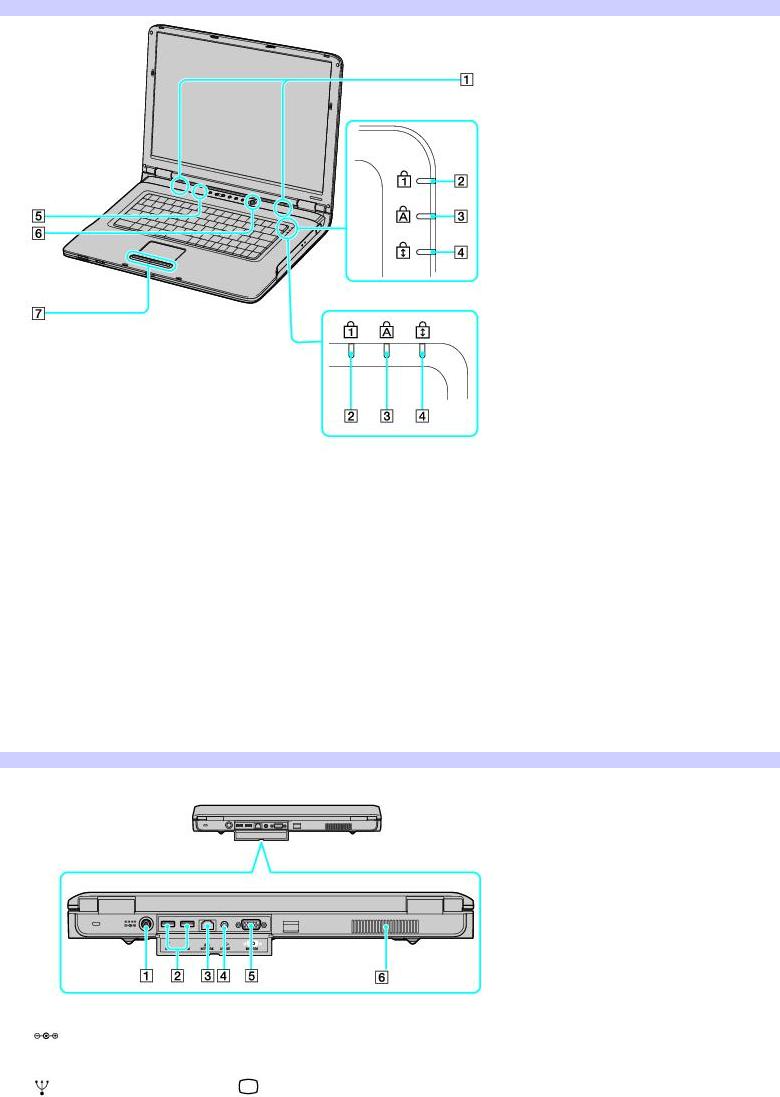
Front
1 |
Speakers 5 |
Brightness sensor |
||
2 |
Num lock indicator1 |
6 |
Power button |
|
3 |
Caps lock indicator2 |
7 |
Left and right buttons |
|
4 |
Scroll lock indicator3 |
|
|
|
1Indicator appears on the top or right corner of the keyboard depending on the model that you purchased.
2Indicator appears on the top or right corner of the keyboard depending on the model that you purchased.
3 Indicator appears on the top or right corner of the keyboard depending on the model that you purchased.
Back
1 |
DC In port 4 |
AV Out jack |
|
|
2 |
USB 2.0 ports1 |
5 |
Monitor (VGA) port |
Page 9 |
|
|
|
|
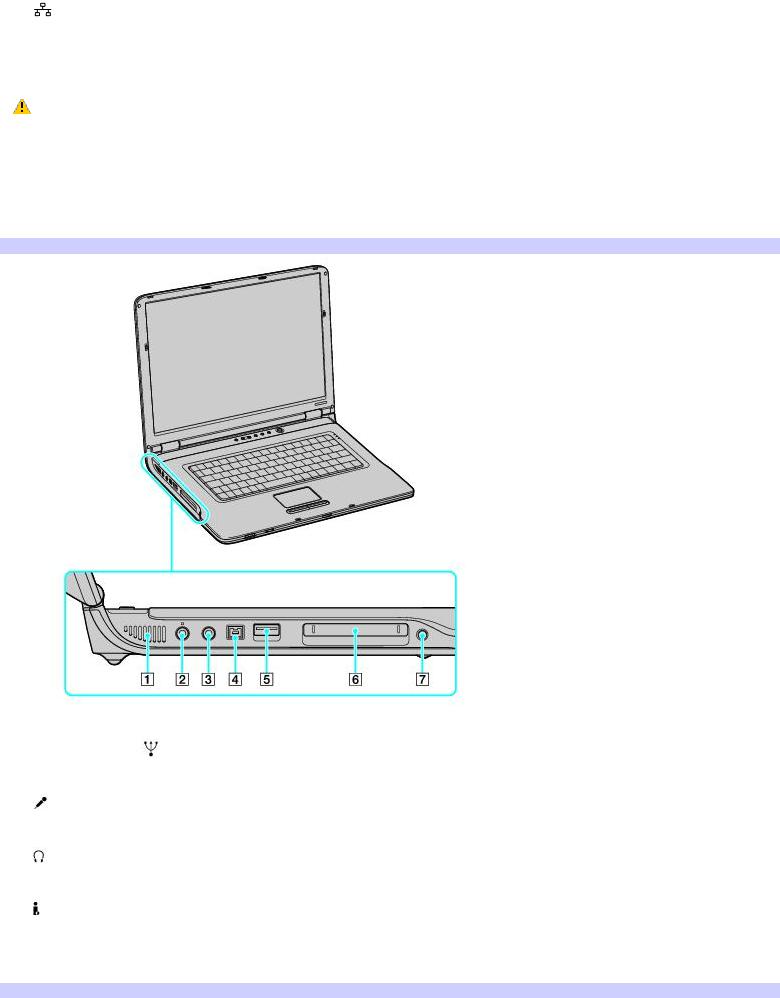
3 |
Network (Ethernet) port |
6 |
Air vent |
1 Supports high-/full-/low- speeds.
Only connect 10BASE-T, 100BASE-TX, 1000BASE-TX (available on selected models only) cables to the
 Network (Ethernet) port. Do not connect any other type of network cable or any telephone line to this port. Connecting cables other than those listed above may result in an electric current overload and could cause a malfunction, excessive heat, or fire in the port. To connect the unit to a network, refer to your on-screen VAIO® Computer User Guide or contact your network administrator.
Network (Ethernet) port. Do not connect any other type of network cable or any telephone line to this port. Connecting cables other than those listed above may result in an electric current overload and could cause a malfunction, excessive heat, or fire in the port. To connect the unit to a network, refer to your on-screen VAIO® Computer User Guide or contact your network administrator.
 Only selected models support a 1000BASE-TX connection.
Only selected models support a 1000BASE-TX connection.
Left
1 |
Air vent 5 |
USB 2.0 port1 |
|
2 |
Microphone jack |
6 |
PC Card slot |
3 |
Headphone jack |
7 |
PC Card eject button |
4 |
i.LINK® (IEEE 1394) S400 port |
|
|
1 Supports high-/full-/low- speeds.
Right
Page 10

1 |
Drive eject button |
4 |
Manual eject hole |
|
2 |
Optical drive |
5 |
Modem jack |
|
3 |
Drive eject button |
|
|
|
 You can use either drive eject button to eject the optical drive tray. The drive eject button located next to the optical drive functions only with Microsoft® Windows® operating system.
You can use either drive eject button to eject the optical drive tray. The drive eject button located next to the optical drive functions only with Microsoft® Windows® operating system.
Bottom
1 |
Port replicator connector |
4 |
RELEASE switch |
|
2 |
Air vents 5 |
Battery bay |
|
|
3 |
LOCK/UNLOCK switch 6 |
CONNECT button1 |
||
1 O n selected models with wireless mouse functionality.
Page 11
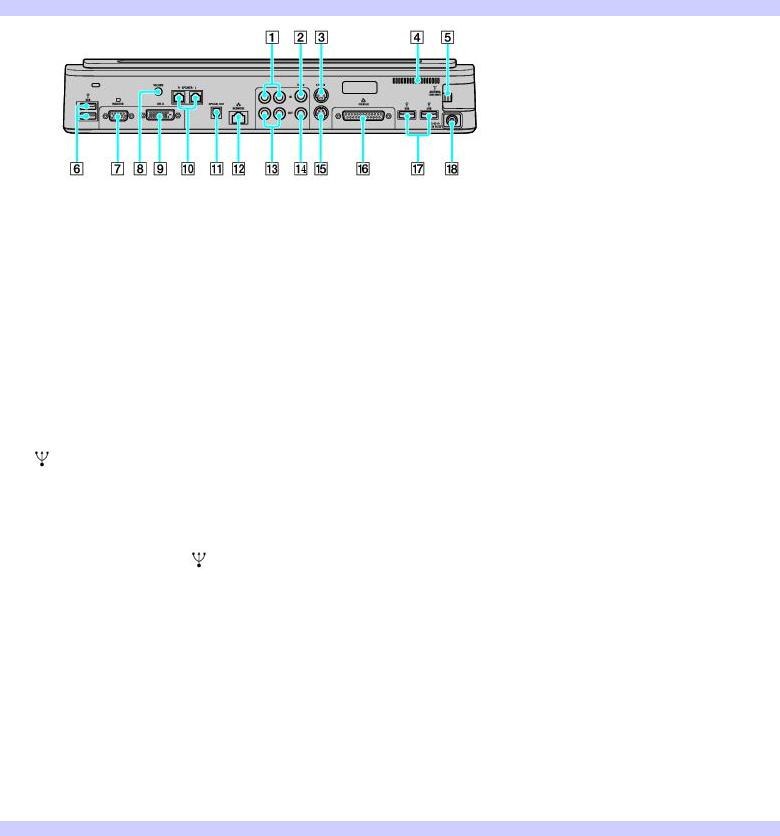
 See "Connecting a Wireless Mouse" in the Mice and Keyboards chapter of your on-screen VAIO® Computer User Guide for more information about using the wireless optical mouse.
See "Connecting a Wireless Mouse" in the Mice and Keyboards chapter of your on-screen VAIO® Computer User Guide for more information about using the wireless optical mouse.
 The printer port on this port replicator is intended for printer connections only.
The printer port on this port replicator is intended for printer connections only.
A/V Port Replicator
1Composite Audio In jacks
2Composite Video In jack 11 Output frequency (48 kHz1/44 kHz)
10 Speaker jacks (right and left)
Optical Out port
3 |
S Video In port |
12 |
Network (Ethernet) port (10BASE-T / 100BASE-TX / 1000BASE-TX2) |
||
4 |
Air vent 13 |
Composite Audio Out jacks |
|||
5 |
VHF/UHF port |
14 |
Composite Video Out jack |
||
6 |
USB 2.0 ports3 |
15 |
S Video Out port |
||
7 |
Monitor (VGA) port |
16 |
Printer port |
||
8 |
Volume jack |
17 |
|
USB 2.0 ports4 |
|
9 |
DVI-D port |
18 |
DC IN port |
||
1 |
O utput frequency is 48 kHz for all frequencies except 32 kHz and 44.1 kHz. |
||||
2 |
O nly selected models support a 1000BA SE-TX connection. |
||||
3 |
Supports high-/full-/low- speeds. |
|
|
||
|
4 Supports high-/full-/low- speeds. |
|
|
||
 The printer port on this port replicator is intended for printer connections only.
The printer port on this port replicator is intended for printer connections only.
Business Port Replicator
Page 12

1 |
Composite Audio In jacks |
8 |
Composite Audio Out jacks |
||
2 |
Air vent 9 |
Composite Video Out jack |
|||
3 |
USB 2.0 ports1 |
10 |
S Video Out port |
||
4 |
Monitor (VGA) port |
11 |
Printer port |
||
5 |
DVI-D port |
12 |
|
USB 2.0 ports2 |
|
6 |
Optical Out port |
|
|
|
|
Output frequency (48 kHz3/44 kHz) 13 |
DC IN port |
||||
7 |
Network (Ethernet) port (10BASE-T / 100BASE-TX / 1000BASE-TX4) |
||||
1Supports high-/full-/low- speeds.
2Supports high-/full-/low- speeds.
3 O utput frequency is 48 kHz for all frequencies except 32 kHz and 44.1 kHz.
4 O nly selected models support a 1000BA SE-TX connection.
Page 13

About the Indicator Lights
Indicator Function
Power
 Turns on when the power to the computer is on, blinks in Standby mode, and turns off when the computer is in Hibernate mode or off.
Turns on when the power to the computer is on, blinks in Standby mode, and turns off when the computer is in Hibernate mode or off.
Battery
Turns on when the computer is using battery power, blinks when the battery is running out of power, double-blinks when the battery is charging.
Memory Stick®
 Turns on when data is read from or written to the Memory Stick media. (Do not enter Standby mode or turn off the computer when this indicator is on.) When the indicator is off, the Memory Stick media is not being used.
Turns on when data is read from or written to the Memory Stick media. (Do not enter Standby mode or turn off the computer when this indicator is on.) When the indicator is off, the Memory Stick media is not being used.
Hard Disk
 Turns on when data is read from or written to the hard disk. Do not enter Standby mode or turn off the computer when this indicator is on.
Turns on when data is read from or written to the hard disk. Do not enter Standby mode or turn off the computer when this indicator is on.
Num Lock
 Press this key to activate the numeric keypad. Press it a second time to deactivate the numeric keypad. The numeric keypad is not active when the indicator is off.
Press this key to activate the numeric keypad. Press it a second time to deactivate the numeric keypad. The numeric keypad is not active when the indicator is off.
Caps Lock
 Press this key to type letters in uppercase. Letters appear in lowercase if you press Shift while the indicator is on. Press the key a second time to turn off the indicator. Normal typing resumes when the Caps Lock indicator is off.
Press this key to type letters in uppercase. Letters appear in lowercase if you press Shift while the indicator is on. Press the key a second time to turn off the indicator. Normal typing resumes when the Caps Lock indicator is off.
Scroll Lock
 Press this key to change how you scroll the display. Normal scrolling resumes when the Scroll Lock indicator is off. The Scroll Lock key functions differently depending on the program you are using and does not work with all programs.
Press this key to change how you scroll the display. Normal scrolling resumes when the Scroll Lock indicator is off. The Scroll Lock key functions differently depending on the program you are using and does not work with all programs.
Bluetooth®1 |
Turns on when the wireless switch is set to ON and Bluetooth technology is enabled. |
Wireless |
|
LAN1 |
Turns on when the wireless LAN function is running. |
1 O n selected models only.
 See Internet and Network Connections for more information about Bluetooth and wireless technology.
See Internet and Network Connections for more information about Bluetooth and wireless technology.
Page 14

Using Special Buttons
Your VAIO® computer is equipped with a variety of audioand video-oriented function buttons: Volume, Brightness, and Magnify screen.
Page 15
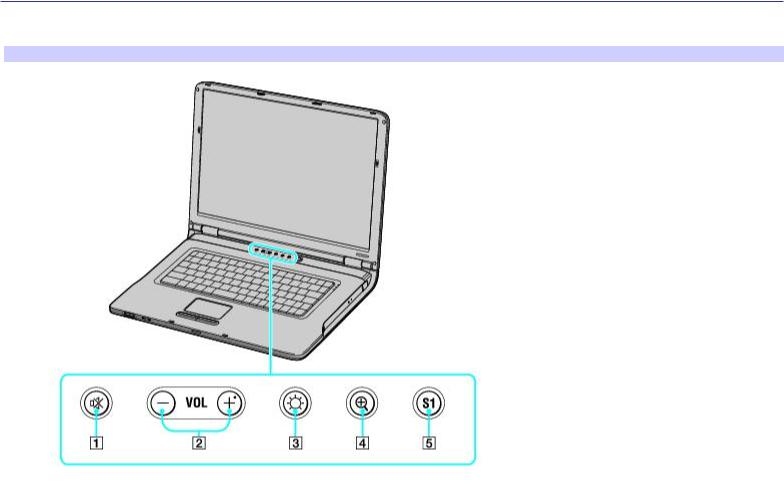
About the special buttons
The following information shows where the special buttons are located, and briefly describes their functionality.
Special Buttons
Number Type of Button
1Mute. The Mute button enables and disables the audio output when using headphones or the internal speakers. This button does not enable and disable the audio output for Optical Out, Line Out, or AV Out connections. The Mute button illuminates when the audio output is disabled.
2Volume. The Volume buttons control the audio output on your computer.
3Brightness. The Brightness button, located between the Magnify screen and Volume buttons, toggles brightness levels for the computer's LCD screen. There are three brightness settings: Auto, Brightness, and Max. The brightness button illuminates when the brightness level is set to Brightness or Max.
4Magnify screen. The Magnify screen button, located next to the computer's brightness button, works as a screen resolution toggle button. By pressing it, you can alternate between different screen resolutions.
5S1. The S1 button is a pre-programmable button that enables you to enter a power saving mode, switch between displays, or launch an application.
Page 16
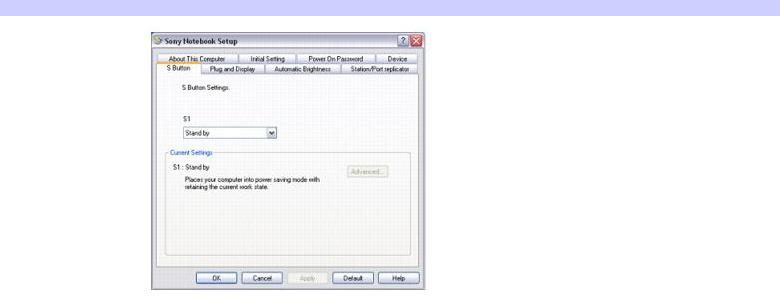
Using the S1 button
As a shortcut, you can assign a pre-programmable S1 button to enter a power saving mode, switch between displays, or launch an application.
To assign a function to a programmable button
1.Click Start, and point to All Programs and then Sony Notebook Setup.
2.From the Sony Notebook Setup submenu, click Sony Notebook Setup.
 If no function has been assigned to the button yet, you can also press the S1 button on the computer to launch Sony Notebook Setup.
If no function has been assigned to the button yet, you can also press the S1 button on the computer to launch Sony Notebook Setup.
3.Click the S1 Button tab.
Sony Notebook Setup
4.Click to select a key assignment from the S1 drop-down menu.
5.Click Apply.
6.Depending on the key assignment, you may be able to customize the S1 button further by clicking Advanced, if it becomes available, in the Current Settings box.
Page 17
Additional information about adjusting the brightness of the LCD screen
Your computer comes with a brightness sensor that automatically increases and decreases the LCD screen's brightness level depending on the amount of external light. The automatic sensor is engaged the first time you turn on your computer. To override the automatic setting and manually adjust the brightness, follow these steps:
Press the Brightness button, located next to the Volume buttons, and select one of the three brightness settings (Auto, Brightness, and Max).
Press the Fn and F6 keys to increase brightness.
Press the Fn and F5 keys to decrease brightness.
Page 18

Mice and Keyboards
Using the Keyboard
Although your computer's keyboard is very similar to a typewriter's keyboard, you can use the additional keys on the computer's keyboard to perform specific computer-related tasks.
Page 19

Mice and Keyboards
Using the Keyboard
Although your computer's keyboard is very similar to a typewriter's keyboard, you can use the additional keys on the computer's keyboard to perform specific computer-related tasks.
Page 20

Keyboard descriptions
Key |
Description |
 The numeric keypad contains the keys found on a typical calculator. Use the numeric keypad to type numbers or perform mathematical calculations, such as addition and subtraction. Numbers appear on the front beveled edge of the numeric keys. Press the Num Lock key to activate the numeric keypad. (When you do so, the Num Lock indicator light turns on.) Press the Num Lock key again to deactivate the numeric keypad.
The numeric keypad contains the keys found on a typical calculator. Use the numeric keypad to type numbers or perform mathematical calculations, such as addition and subtraction. Numbers appear on the front beveled edge of the numeric keys. Press the Num Lock key to activate the numeric keypad. (When you do so, the Num Lock indicator light turns on.) Press the Num Lock key again to deactivate the numeric keypad.
 The arrow keys move the pointer on the screen. They also function as the Home, End, Page Up, and Page Down keys, respectively, when the Fn key is pressed.
The arrow keys move the pointer on the screen. They also function as the Home, End, Page Up, and Page Down keys, respectively, when the Fn key is pressed.
The correction keys enable you to make corrections to keystrokes.
 The 12 function keys along the top of the keyboard perform designated tasks. For example, in many programs, F1 is the Help key. The task associated with each function key may vary from one program to the next.
The 12 function keys along the top of the keyboard perform designated tasks. For example, in many programs, F1 is the Help key. The task associated with each function key may vary from one program to the next.
The Escape key cancels commands.
 The Print Screen key takes an electronic snapshot of the screen and moves it to the Clipboard. You can then paste the screen shot into a document and print it.
The Print Screen key takes an electronic snapshot of the screen and moves it to the Clipboard. You can then paste the screen shot into a document and print it.
 The operator keys provide a variety of commands. For example, in many programs, instead of choosing the Save command from a menu, you can hold down Ctrl and press S (referred to as Ctrl+S). Also, the Shift key to produces capital letters or special symbols, such as @ and $.
The operator keys provide a variety of commands. For example, in many programs, instead of choosing the Save command from a menu, you can hold down Ctrl and press S (referred to as Ctrl+S). Also, the Shift key to produces capital letters or special symbols, such as @ and $.
 The Windows key opens the Start menu. It is the equivalent of clicking Start on the Windows® taskbar. See Windows key combinations for more information.
The Windows key opens the Start menu. It is the equivalent of clicking Start on the Windows® taskbar. See Windows key combinations for more information.
 The Fn key is used in combination with other keys to issue commands. See Fn key combinations for more information.
The Fn key is used in combination with other keys to issue commands. See Fn key combinations for more information.
 The Applications key opens a shortcut menu of context-sensitive choices. It is the equivalent of clicking the right mouse button.
The Applications key opens a shortcut menu of context-sensitive choices. It is the equivalent of clicking the right mouse button.
Page 21

Windows key combinations
Key combination |
Function |
||
+F1 |
|
Displays the VAIO Help and Support Center window. |
|
+Tab |
Switches the selected button on the taskbar. |
||
+D |
|
Displays the desktop. |
|
+E |
|
Displays the My Computer window. |
|
+F |
|
Displays the Search Results window, where you can find a file or folder. This is the equivalent of selecting |
|
Search from the Start menu. |
|||
+Ctrl+F |
Displays the Search Results - Computers window, where you can locate other computers. This is the |
||
equivalent of selecting Search, and then Computer from the Start menu. |
|||
+M |
|
Minimizes all displayed windows. |
|
Shift+ |
+M |
Returns all minimized windows to their previous size. |
|
+R |
|
Displays the Run window. This is the equivalent of selecting Run from the Start menu. |
|
Fn+ |
+Insert |
|
Displays the System Properties window. This is the equivalent of selecting Control Panel, and then |
System from the Start menu.
Page 22

Fn key combinations
Key combination |
Function |
|
Fn+F5 |
Decreases the LCD screen brightness. |
|
Fn+F6 |
Increases the LCD screen brightness. |
|
Fn+F7 Toggles the display between the computer screen (LCD), a connected external display, and both the LCD and an external display.
Select one display when playing a DVD. Connect the cable(s) before you turn on the computer; otherwise, Fn+F7 will not
work. |
|
Fn+F12 |
Puts the system into Hibernate mode, a power management state. To return the system to normal operating |
mode, press the power button. Hibernate mode consumes the lowest level of power. |
|
Fn+Esc |
Puts the system into Standby mode, a power management state. To return the system to the active state, |
press any key or the power button.
Page 23

Connecting a Mouse or Keyboard
Your computer is compatible with many popular mice and keyboards. To function properly, the device you connect must be compatible with the Microsoft® Windows® operating system installed on your computer.
Page 24
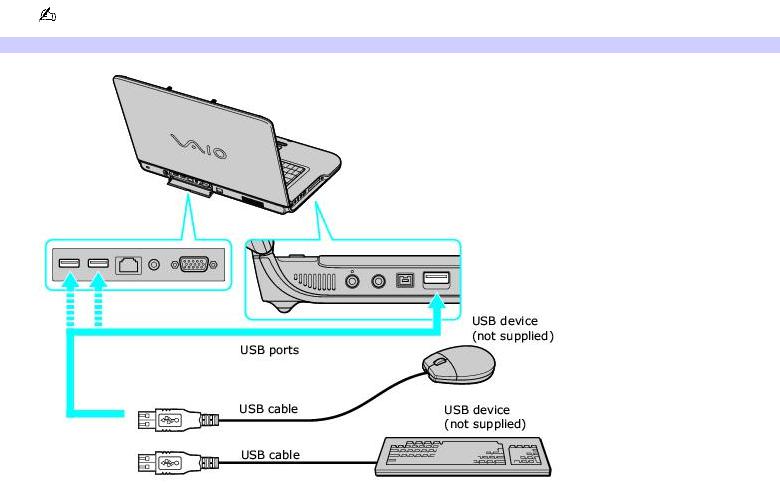
Connecting a mouse or keyboard
If you connect the mouse or keyboard when the computer is on, you may need to restart the computer for it to recognize the device.
To connect a USB mouse or keyboard to your computer
1.Plug the USB cable into the USB port  . See Locating Controls and Ports.
. See Locating Controls and Ports.
One USB port supports one USB connection.
Connecting a USB Mouse or Keyboard
2.If the New Hardware Wizard appears, follow the on-screen instructions to complete the installation process.
 Although the New Hardware Wizard guides you through the software installation, some devices require separate driver software installation. See the instructions that accompanied your mouse or keyboard for more information
Although the New Hardware Wizard guides you through the software installation, some devices require separate driver software installation. See the instructions that accompanied your mouse or keyboard for more information
Page 25
Disconnecting a mouse or keyboard
You can disconnect a USB mouse or keyboard when the computer is on or off. However, disconnecting the mouse or keyboard when the computer is in a power saving mode (Standby or Hibernate) may cause the computer to malfunction.
To disconnect a mouse or keyboard
Unplug the USB cable from the USB port.
Page 26
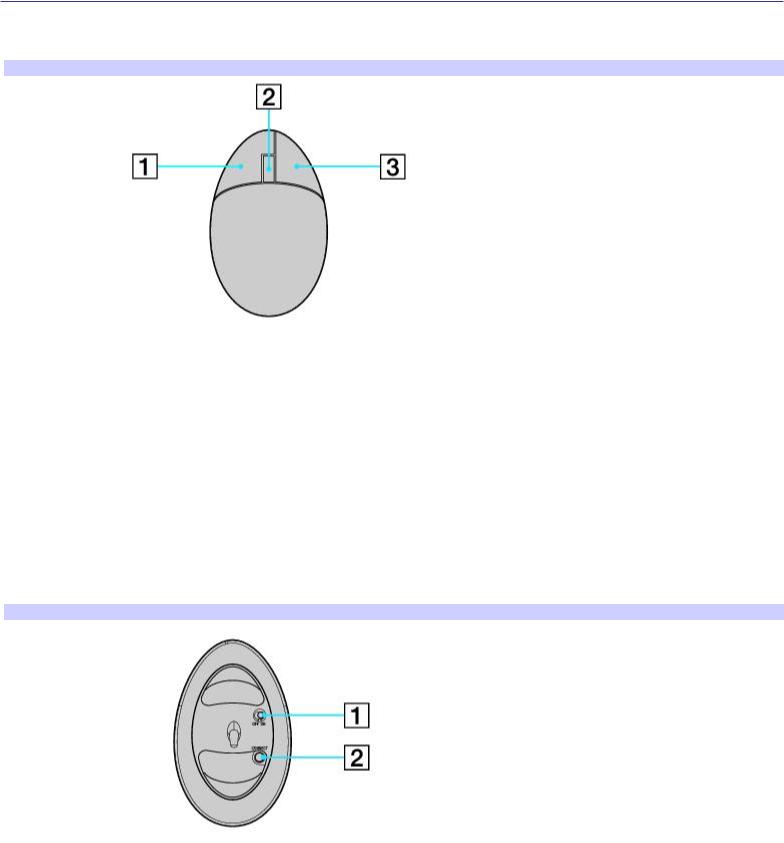
Connecting a Wireless Mouse
A wireless mouse is optional with your VAIO® computer. The following section explains the parts of the wireless mouse and how it works.
Wireless mouse (top)
1 Left mouse button
Press to perform specific mouse functions.
2 Wheel button
Rotate the wheel to scroll up or down on the LCD screen.
3 Right mouse button
Press to perform specific mouse functions.
Wireless mouse (bottom)
1 Power switch
Slide power switch to turn the mouse on or off.
2 CONNECT button
Press to enable communication between your VAIO® computer and the wireless mouse.
Page 27
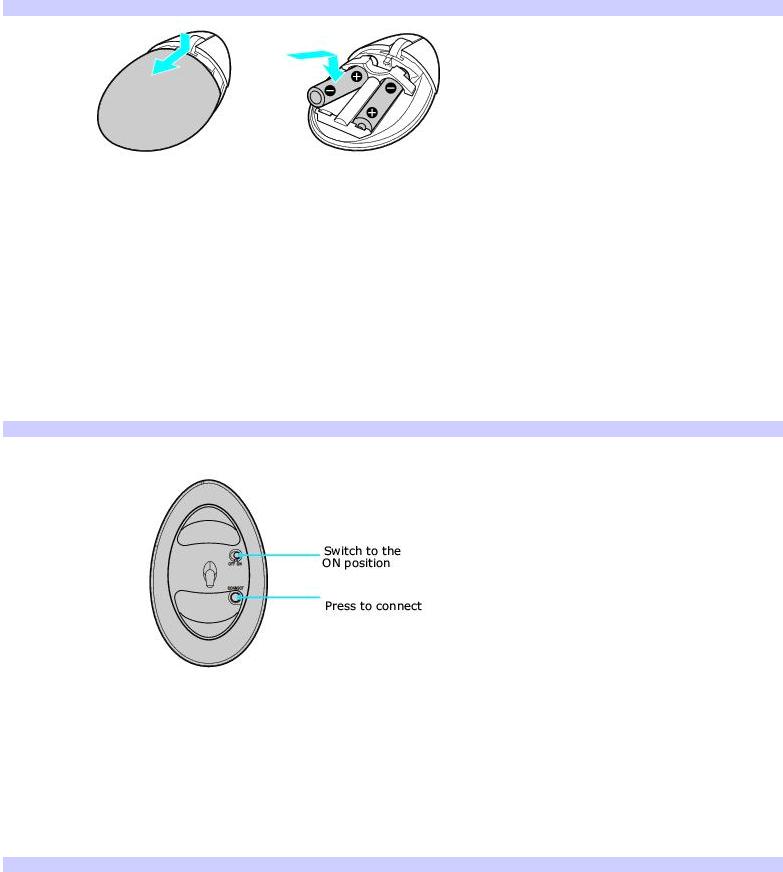
To set up the wireless mouse
Insert two AA batteries (supplied with the mouse) into the wireless mouse as shown.
Inserting batteries into the wireless mouse
 If your wireless mouse does not operate properly, the batteries may need to be replaced. When your wireless mouse is not being used for extended periods of time, remove the batteries to avoid possible damage from battery leakage.
If your wireless mouse does not operate properly, the batteries may need to be replaced. When your wireless mouse is not being used for extended periods of time, remove the batteries to avoid possible damage from battery leakage.
To connect the wireless optical mouse
Before attempting to use the wireless mouse, you must enable communication between the computer and the mouse.
 When attempting to connect the wireless mouse, confirm that the AA batteries (supplied) are properly inserted into the mouse before your computer is turned on.
When attempting to connect the wireless mouse, confirm that the AA batteries (supplied) are properly inserted into the mouse before your computer is turned on.
1.Turn the wireless mouse over.
2.Slide the power button on the wireless mouse to the ON position.
Connecting the mouse
3.Turn on your computer.
4.Reach underneath the right side of the computer and press the CONNECT button.
5.Immediately, press the CONNECT button on the wireless mouse.
 Make sure to press the CONNECT button on the wireless mouse within 30 seconds after pressing the CONNECT button on the computer. The wireless mouse must be within 12 inches of the computer.
Make sure to press the CONNECT button on the wireless mouse within 30 seconds after pressing the CONNECT button on the computer. The wireless mouse must be within 12 inches of the computer.
Positioning the mouse
Page 28
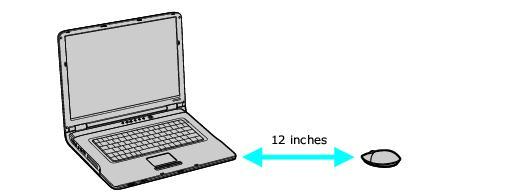
6.Place the optical mouse on an appropriate surface to enable tracking.
Page 29
Additional information about the wireless optical mouse
The wireless optical mouse requires an ideal surface texture in order to provide precision pointing and tracking.
Use surfaces such as plain paper, card stock, or fabric that have minimal repetitive patterns.
Avoid surfaces such as mirrors, smooth glass, or magazines that have halftone printing.
The wireless optical mouse requires unobstructed communication with the system unit for proper operation.
Do not exceed a maximum distance of 2 feet between your VAIO® computer and your wireless mouse.
Confirm that the supplied AA batteries are properly installed.
Press the Connect buttons located underneath the right side of the computer and on the bottom of the mouse, to establish the communication between the equipment.
Verify the infrared receiver on the computer's front panel is free of obstructions that may prevent proper operation.
Avoid using radio-controlled toys or equipment, CB radios, and other wireless devices in the area near your wireless mouse. These devices may cause interference, causing your mouse to stop working properly.
Do not place metal furniture near your computer or wireless mouse, as this may create interference, causing your mouse to stop working properly.
Page 30
